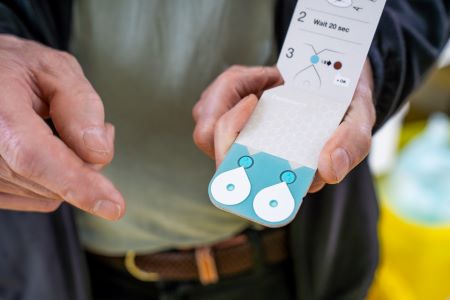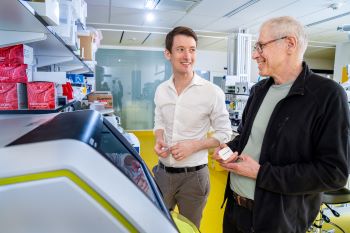Research Collaboration Revolutionizes Blood Sample Analysis
Region Stockholm

Blood sample on a piece of paper sent by post is the result of a research project made possible by the Health, Medicine and Technology (HMT) initiative. The collaboration between researchers at KTH and clinicians at Region Stockholm has been crucial to the project’s success.
“We can now see this product being used worldwide for various applications. We have created growth and job opportunities, including positions in Stockholm. We’re pretty proud of that,” says Niclas Roxhed, Associate Professor and a team leader of medical microsystems at KTH.

It started nearly ten years ago. Olof Beck, a professor at Karolinska Institute working with blood sample analyses, saw a need to streamline and simplify the sampling process. Partly to reduce the need for repeated hospital visits for people who require frequent blood tests and partly to ensure precise blood volume analysis.
After a while, Beck contacted Roxhed.
“We started quickly with a project initiated by a thesis. We realized early on it was successful and wanted to continue. We applied for research funding through the HMT initiative, and once granted, we could advance the project,” Roxhed explains. Beck adds:
“Normally, blood samples are taken with a needle in the arm, requiring professional input. Alternatively, a finger prick can be used, but you don’t know the blood volume until analysis. Our invention solves this problem.”
The research project resulted in a card that uses capillary forces to measure blood volume from a drop of blood. The card features two valves to handle excess blood, ensuring the analysis sample is always 10 microliters.
“The advantage is that the sample is ready for analysis upon arrival, so you can start the procedure immediately,” says Beck. Roxhed adds:

“Additionally, the blood dries on the paper, eliminating the biohazard risk, allowing it to be sent by regular mail. These samples don’t require refrigeration and work at room temperature.”
In 2016, the company Capitainer was launched to commercialize the research. Today, the company employs 25 people and the product is used globally, primarily for research but also in some hospitals. Capitainer has a subsidiary in the US conducting studies in various states, analyzing blood for lead and other heavy metals.
“This cooperation has been crucial in enabling us to do what we do today. We started this project in 2013 with funding from the HMT initiative, which allowed us to continue our research, start a company, and now see this product used globally in various applications,” Roxhed states.
Beck emphasizes that collaboration is essential for success in complex projects. Roxhed concludes:
“As an engineer, I focus on technical solutions, but it’s crucial to test these solutions in practice. That’s where you see if they hold up and refine your ideas. This has been an absolutely crucial part of the process.”
You have previously denied the display of content of the type "External media". Do you want to show content?
Text: Annelie Englund
Photo: Magnus Glans
